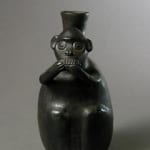Chimu Blackware Stirrup Vessel Depicting a Monkey, 900 CE - 1400 CE
Terracotta
6.5
PF.5815
Further images
The Chimu culture arose around 800 A.D. and flourished until the Incan conquest about six hundred years later. Their civilization was centered at their capital Chan Chan, about 300 miles...
The Chimu culture arose around 800 A.D. and flourished until the Incan conquest about six hundred years later. Their civilization was centered at their capital Chan Chan, about 300 miles north of Lima, literally meaning “Sun Sun,” the largest Pre-Columbian city in Peru estimated to contain almost one hundred thousand citizens. The Chimu believed the sea, which they called “Ni,” was the origin of life, a theory also proposed by modern science and evolution. Thanks to their sea-faring skills, the Chimu were able to survive, nestled in between the desert and the sea. The sea was everything to them: an endless supply of food and the source of inspiration for their most imaginative myths, legends, and artwork. Agriculture was also vital, and the Chimu drew up a vast number of irrigation works demonstrating immense engineering skill, some of which are still in use today. Today, aside from the astounding mud ruins of Chan Chan remarkably well preserved in the heat of the desert, the Chimú are perhaps best known for their distinctive black glazed pottery influenced by their predecessors: the Moche.
This charming vessel depicts a monkey eating an ear of corn. Maize was one of the most vital crops to the Pre-Columbian cultures of Peru. Perhaps there is a symbolic significance to this representation involving the great maize god. Perhaps the monkey itself is significant. Maybe this creature was the prized pet of a noble aristocrat. However, today, like much of Chimu culture, this meaning of this vessel is shrouded in mystery. Although we will never be able to fully understand the importance of such a piece, we can still easily appreciate its extraordinary artistry and charming subject matter. The facial features of the monkey are rendered with the detail and attention normally reserved for human portraiture. Its arms and head both elegantly emerge from the contours of the vessel while its legs are subtler. Perhaps the most delightful feature is the monkeys curled tail added to the bottom of the back, which is otherwise unadorned. Entombed alongside the deceased, this vessel was as necessary in the afterlife as it was in this world.
This charming vessel depicts a monkey eating an ear of corn. Maize was one of the most vital crops to the Pre-Columbian cultures of Peru. Perhaps there is a symbolic significance to this representation involving the great maize god. Perhaps the monkey itself is significant. Maybe this creature was the prized pet of a noble aristocrat. However, today, like much of Chimu culture, this meaning of this vessel is shrouded in mystery. Although we will never be able to fully understand the importance of such a piece, we can still easily appreciate its extraordinary artistry and charming subject matter. The facial features of the monkey are rendered with the detail and attention normally reserved for human portraiture. Its arms and head both elegantly emerge from the contours of the vessel while its legs are subtler. Perhaps the most delightful feature is the monkeys curled tail added to the bottom of the back, which is otherwise unadorned. Entombed alongside the deceased, this vessel was as necessary in the afterlife as it was in this world.





